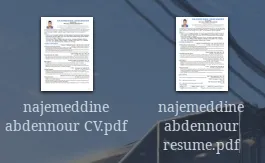Whether you are a fresh graduate our still pursuing a university degree, having a well written and updated CV/Resume is a must in this day and age. Particularly, in the current economic downturns and the latest layoffs that can make you panic and feel unease about your future career.
The problem is that during this academic path or even after it, you are rarely presented with a clear and simple guide to generate a CV that can get you even noticed in the job market. I think that this is honestly strange since the goal of getting into university in the first place is getting you ready for the job market and preparing you to get hired. Yet, most education institutions don’t even bother themselves and even when they do, they usually hire an old instructor that lost touch with the rapidly changing job market and has some outdated materials that he keeps using for all his lectures.
So in order to write a CV and a Resume that eventually got me noticed even by big tech companies like Amazon, here’s what I learned during my research and many trial and error experiments for this subject.
1- YOU NEED TO ENSURE YOU ARE VISIBLE
Avoid trying to invent the wheel
One of the most common mistakes that a lot of people fall into, and I have been guilty of doing the same thing before, is trying to invent the wheel and using non-conventional and drastically unorthodox templates to try to distinguish themselves. Well, they are certainly doing that but for the wrong reasons.
In my experience, hiring managers and HR recruiters only care about the content and your compatibility with the position. And believe me I learned this the hard way, now I only use white background and simple but formal template, which increased the number of return calls from recruiters 3-4 times more.
Clear and all inclusive contact information
Another very important and must do step is having a clear header to my CV with name and title followed by location (I recommend including only the city ) and contact information such as phone number, email, Linkedin and Github (if you are in the software development field) as well as whether you are willing to relocate if applicable. Please avoid any personal information, since they can be more harmful than useful in most cases.

Include an optimized Linkedin profile
Another advice that I need to emphasize is providing acomprehensive
and well established Linkedin profile. As mentioned in this
statista
article, a candidate that includes a link to a well
presented Linkedin profile has 71% more chances to get a callback for a job
interview.
ATS friendly layout
Another impactful aspect to your visibility to the hiring managers is having a CV or a Resume that is ATS friendly. ATS stands for (Applicant Tracking Systems) which is simply put a software used especially by big companies to shortlist candidates by matching their CV/Resume to the job description.
This software scans your CV and if this operation goes wrong, you can be discarded without the recruiter even seeing your CV. To avoid this, you need to test your CV on an ATS software and make sure it can be scanned from the pdf file and in my opinion it is also preferable to avoid using two column layouts, since they are known to cause problem for these softwares in the past at least. I will provide a link to online services that you can use for this in the last section .
Professional file format
Lastly, I encourage you to name the file of your resume with your name and surname followed by the word resume or CV and present it to the recruiter/hiring manager in a PDF fromat, believe me they will really appreciate it, you can avoid any issues that can be caused by other formats and naming schemes and you will be perceived as a professional.

2- HOOK THE READER OF YOUR CV
Quantify your achievements
Well, as any story teller, you need to hook the reader of your application. Especially, when the average recruiters spends 6-8 seconds looking at your CV according to this Industry research.
The best hook that you can provide is to Quantify your achievements. Everyone knows that companies love money and numbers, so give them what they want. You need to always include numbers and quantities in the content of your CV as much as you can. Tell them why they need you with numbers. Use figures, percentages and numbers and showcase the importance of your results and what you can provide to the company.
Use bulletpoints and action verbs
As I showed in the example below, another thing that you must do is use bulletpoints to describe everything in a brief manner. In my opinion with the exception of the summary, which you can also script with bulletpoints, everything that you need to mention needs to be written in concised bulletpoints, typically 3 bulletpoints or less with each bulletpoint represented in two lines or 20-40 words phrases. The summary section is optional and should be straight after the header, however, it is mostly recommended for people with 2 years of professional experience or more (not a good idea for fresh graduates). You also need to start these bulletpoints with action verbs and try to diversify the vocabulary and avoid using the same verbs if possible.



Follow the STAR or STI method
Another thing that you need to learn to do in your CV and when asked about your past experiences in job interviews is using the STAR or STI method when talking about your past roles. The STAR method stands for Situation, Tasks, Actions, Results, similarly STI is Situation, Tasks, Impact. These two methods are the best possible ways to represent your past experiences in understandable, concised and well presented style of writting. In situation you describe the premise of the project, role and the parties or the groups involved, Tasks you define the tasks that you were assigned, Actions the steps you realized and finally, Results or Impact is where you showcase the goals and accomplishments achieved during this role or project. This approach matches and integrates easily with the previously mentioned 3 bulletpoints layout where each bulletpoint is an element of the STI method.
3- THE FULL STRUCTURE AND ORDER OF SECTIONS
The difference between CV and Resume
You need to understand the difference between resume and CV in the first place, which are commonly used interchangeably yet they have different meanings and use cases.
Resume is supposed to be a one page summary of your accomplishments and it has become now the standard with most companies looking to hire, in rare cases Resumes can be two pages. CV on the other hand, can be two or three pages and sometimes eve n more, it includes the history of your whole career and it is now typically used for academic purposes, yet some companies prefer the CV form over the Resume.
Personally, I have both schemes prepared and ready. I also use them interchangeably depending on the context. Make your own judgment over which version to send for your job application, but honestly they should not be so different from each other, Resume supposed to be just a brief version of a CV.
Sections and their orders
The best approach to setup your CV/Resume is to place the most important information on top. Following the header that includes your contact information, a summary of 2-3 lines can be used if applicable (as I previously mentioned not advised for people with no experience).
Then, in my case (IT sector) I think the skills section should be included with a number of keywords that can match the skills mentioned in any job description matching your desired position. If you think that this strategy is compatible with your field of work, you should do the same.
Afterwards, the career experience section comes before the education section, if you have a more interesting career experience than your education and have some background in previous roles related to the job you are applying for. The rest is up to your preferences when it comes to the order and what to include, you can add teaching experiences, projects, certifications, languages, publications, awards and accomplishments, activities, organizations that you represent and you have memberships in, and conferences and events that you attended.
What about fresh graduates with no experience ?
If you are a fresh graduate, do not panic since you don’t have any career experience, you can replace that section with internships, personal projects and certifications and other accomplishments that are linked to the desired role.
Additionally, even the companies that are looking to hire, they need people who are fresh graduate especially start-ups, so as long as you include keywords and skills related to the job description, and follow the other recommendations that I included you will be noticed.
You can also show that you are ready to make an effort by writing directly to the hiring manager or recruiter about the position that you want and include some words about your passion and love for the field and for that particular position in a motivational letter or include a recommendations letter from one of your professors. It might look outdated or unoriginal to you, but believe me it works, especially if you are the only applicant that did that compared to a handful of others candidates that only delivered their CVs.
Bonus tips and final words
One of the best ways to know the effectiveness of your CV/Resume is the feedback that you will receive when you apply for some positions. However, you can also use some online services that provide resume review and rating to see what your previous resume scores compared to your new one. They can also help you see if your CV/Resume is ATS friendly. I know that the free versions and free trials are limited but use them wisely and they will be enough. Here is a list of some of these websites:
As long as you can have a score above 70%, you have a good setup. Personally, I managed to improve my CV/Resume using these guidelines from a 33% rating to 87% and to be honest, the effect is very noticeable in real life.
Feel free to leave a comment and discuss more if you think that I forget something or I can improve some aspect according to your experience and good luck on your job search and career journey, sometimes a little bit of luck is just what is missing. ;)
